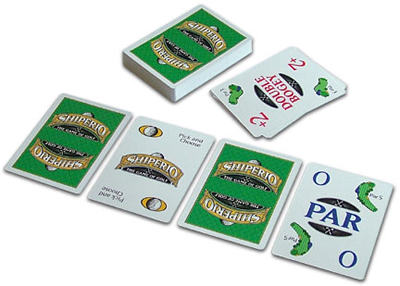 Good table games based on golf are as hard to find as birdies on the Road Hole at St. Andrews. In fact, outside of the truly addictive GOLO dice golf game, I’ve never played one.
Good table games based on golf are as hard to find as birdies on the Road Hole at St. Andrews. In fact, outside of the truly addictive GOLO dice golf game, I’ve never played one.
Until recently, that is, when I had a chance to play a couple “rounds” with a card game called Shiperio. Aside from the obscure name (after a few beers, it became more like “Shipiro” with my playing partners), this card game is fun whether you are an avid golfer or not.
Shiperio can be played by as few as two players or as many as six. I’ve played with two and four, and they were equally fun. The strategy is the same as a round of golf: try to end up with the lowest score at the end of the game. Each hand is counted as a hole. It took a little more than 30 minutes to play a leisurely 18-hole round with two people, and a little more than double that with four people (this includes the beer factor).
The Shiperio deck is made up of a series of cards that have a score value in relation to par, from the rare 2-under-par Ace and Eagle cards to the dreaded Snowman. The majority of the cards are anywhere from 4-over-par (with OUCH printed on each such card) to 1-under par.
Each player is dealt four cards face down, arranged in a left-to-right row. You’re allowed to look once at the two cards on the outside hand, the card on the far left and the one on the far right. The two cards in the middle remain a mystery for a brief moment. Looking at these two outside cards is very important. Memorizing exactly what they are can turn out to be a key part of the game.
The remaining cards are placed in a stack in the middle of the table, with the top card turned over into a discard pile. The player to the left of the dealer is then “on the tee” to start the hole.
Each player has the option of taking the card on the top of the discard pile and using it to replace one of the four cards in their hand. Once you make this decision, you must put that card into your four-card row face up while discarding the card that it replaces. Once a card is face up in your hand, it cannot be replaced (with one dramatic exception that we’ll come to later) and becomes part of your score for the hole.
If the card atop the discard pile is a high score, you can choose to draw a new card from the play stack in the middle. You then have the option of either taking that card into your hand to replace a face-down card, or discarding the card you’ve just drawn and simply flipping one of your original four cards over.

This is one of the reasons it is key to pay attention to the two cards you’re allowed to peek at. If you know you have a 3-over-par card in your hand and you draw a 1-over-par card, you may choose to grab the 1-over card even though it isn’t a great score – but it is better than what you had.
Each person ends up exposing one more card each time around until all four cards are face up for each player. Then you add up the scores – except for the dramatic exception I mentioned earlier. There is one bigtime wild card in the mix: the Shiperio card. If you draw the Shiperio card, you get the chance to poach another player’s best card. Here’s how it works. When you get to the end of the hole, the player with the Shiperio card draws a card to replace that card in their hand. If the newly drawn card is a good one, they can keep it. But if it is bad, they can give it to another player and take any card that player has in return. Like any good card game, this is where things can get really snide.
One other twist is that most of the standard cards come in three colors: red, blue, and green. If you end up with two of the same color card – like two blue bogeys – in your hand, they cancel each other out and equal a par score. So if you know you have a red triple bogey in your hand and you turn a match up, you can make the counterintuitive choice to pick up the second red triple bogey and come out of it with a net par. Of course, this can also hurt you. If you end up with a couple blue birdies, for example, they’ll cancel each other out instead of giving you a two-under-par boost.
Like the actual on-course game of golf, Shiperio leaves plenty to chance. Those two cards in the middle of your hand that you can’t peek at are a total mystery. You have to go with your gut and hope you don’t turn up a Snowman (which gives you an automatic eight-over-par for that hole, regardless of what else is in your hand).
An alternative way to play Shiperio is to use the scorecard from a real golf course to guide your play. If the first hole on the scorecard is a par-4 and you score one-under-par on the hole, you write down a three for that hole instead of a -1. A fun change of pace that makes the game even more golf-like.
You really don’t need to know much about golf to enjoy Shiperio. Really, it’s just a strategic card game with golf terminology on top. I played with my wife and two friends, and we were all over the map in terms of golf aptitude. Our friend Sally knows next to nothing about the game, while my wife, Meagan, has played a bit. Sally’s husband, Dirk, has also played a bit of golf and follows the game closely. And then there was me. Enough said.
Did my golf expertise help me? Not even a little bit. I was 12-over-par on my first hole, and I never really recovered. Neither Dirk nor I was ever under par, and we finished third and fourth, respectively. Meanwhile, Meagan and Sally went head to head most of the way until Megan’s Nick Faldo-like even play helped her win with a 2-over-par score for 18 holes.
Stung by my 17-stroke loss, I challenged Meagan to a two-player rematch round the next day. Despite a hot start that saw her reach 9-under-par after the fourth hole, Megan blew up on the back 9. Meanwhile, luck was on my side. I was able to finish at 7-under par to Meagan’s 18-over total.
I’d say anyone who enjoys card games and is over the age of 12 would enjoy Shiperio. It moves quickly, has room for strategy, skill and blind luck, and is a very social game. Besides, I’ll take a 7-under-par score anytime, especially when there are inches of snow on the ground outside.
